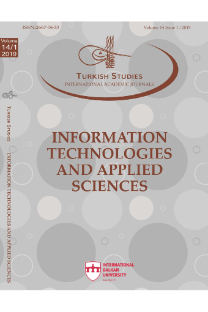MRIKardiyak MR Görüntülerinde Sol Kulakçık Bölütlenmesi İçin Derin Öğrenme Tabanlı Hibrit Model
Deep Learning Based Hybrid Model for Left Atrial Segmentation in Cardiac
___
- Hansen, B. J., Zhao, J., & Fedorov, V. V. (2017). Fibrosis and atrial fibrillation: computerized and optical mapping: a view into the human atria at submillimeter resolution. JACC: Clinical Electrophysiology,3(6), 531-546.
- He, K., Zhang, X., Ren, S., & Sun, J. (2016). Deep residual learning for image recognition. In Proceedings of the IEEE conference on computer vision and pattern recognition (pp. 770- 778).
- Higuchi, K., Cates, J., Gardner, G., Morris, A., Burgon, N. S., Akoum, N., & Marrouche, N. F. (2018). The spatial distribution of late gadolinium enhancement of left atrial magnetic resonance imaging in patients with atrial fibrillation. JACC: Clinical Electrophysiology, 4(1), 49-58.
- Ho, T. K. (1995, August). Random decision forests. In Proceedings of 3rd international conference on document analysis and recognition (Vol. 1, pp. 278-282). IEEE.
- Kingma, D. P., & Ba, J. (2014). Adam: A method for stochastic optimization. arXiv preprint arXiv:1412.6980.
- Krähenbühl, P., & Koltun, V. (2011). Efficient inference in fully connected crfs with gaussian edge potentials. In Advances in neural information processing systems (pp. 109-117).
- LeCun, Y., Bottou, L., Bengio, Y., & Haffner, P. (1998). Gradient-based learning applied to document recognition. Proceedings of the IEEE, 86(11), 2278-2324.
- LeCun, Y., Bengio, Y., & Hinton, G. (2015). Deep learning. Nature, 521(7553), 436-444. Narayan, S. M., Rodrigo, M., Kowalewski, C. A., Shenasa, F., Meckler, G. L., Vishwanathan, M.
- N., ... & Wang, P. J. (2017). Ablation of focal impulses and rotational sources: What can be learned from differing procedural outcomes?. Current Cardiovascular Risk Reports, 11(9), 27.
- Narayan, S. M., & Zaman, J. A. (2016). Mechanistically based mapping of human cardiac fibrillation. The Journal of physiology, 594(9), 2399-2415.
- Njoku, A., Kannabhiran, M., Arora, R., Reddy, P., Gopinathannair, R., Lakkireddy, D., & Dominic, P. (2018). Left atrial volume predicts atrial fibrillation recurrence after radiofrequency ablation: a meta-analysis. Ep Europace, 20(1), 33-42.
- Noh, H., Hong, S., & Han, B. (2015). Learning deconvolution network for semantic segmentation. In Proceedings of the IEEE international conference on computer vision (pp. 1520-1528).
- Papik, K., Molnar, B., Schaefer, R., Dombovari, Z., Tulassay, Z., & Feher, J. (1998). Application of neural networks in medicine-a review. Medical Science Monitor, 4(3), MT538-MT546.
- Park, C., Took, C. C., & Seong, J. K. (2018). Machine learning in biomedical engineering.
- Ren, S., He, K., Girshick, R., & Sun, J. (2015). Faster r-cnn: Towards real-time object detection with region proposal networks. In Advances in neural information processing systems (pp. 91- 99).
- Ronneberger, O., Fischer, P., & Brox, T. (2015, October). U-net: Convolutional networks for biomedical image segmentation. In International Conference on Medical image computing and computer-assisted intervention (pp. 234-241). Springer, Cham.
- Shahid, N., Rappon, T., & Berta, W. (2019). Applications of artificial neural networks in health care organizational decision-making: A scoping review. PloS one, 14(2), e0212356.
- Suykens, J. A., & Vandewalle, J. (1999). Least squares support vector machine classifiers. Neural processing letters, 9(3), 293-300.
- Szegedy, C., Liu, W., Jia, Y., Sermanet, P., Reed, S., Anguelov, D., ... & Rabinovich, A. (2015). Going deeper with convolutions. In Proceedings of the IEEE conference on computer vision and pattern recognition (pp. 1-9).
- Tao, Q., Ipek, E. G., Shahzad, R., Berendsen, F. F., Nazarian, S., & van der Geest, R. J. (2016). Fully automatic segmentation of left atrium and pulmonary veins in late gadolinium‐enhanced MRI: Towards objective atrial scar assessment. Journal of magnetic resonance imaging, 44(2), 346-354.
- Tobon-Gomez, C., Geers, A. J., Peters, J., Weese, J., Pinto, K., Karim, R., ... & Stender, B. (2015). Benchmark for algorithms segmenting the left atrium from 3D CT and MRI datasets. IEEE transactions on medical imaging, 34(7), 1460-1473.
- Veni, Gopalkrishna, et al. "Bayesian segmentation of atrium wall using globally-optimal graph cuts on 3D meshes." International Conference on Information Processing in Medical Imaging. Springer, Berlin, Heidelberg, 2013.
- Veni, G., Elhabian, S. Y., & Whitaker, R. T. (2017). ShapeCut: Bayesian surface estimation using shape-driven graph. Medical image analysis, 40, 11-29.
- Xiong, Z., Fedorov, V. V., Fu, X., Cheng, E., Macleod, R., & Zhao, J. (2018). Fully automatic left atrium segmentation from late gadolinium enhanced magnetic resonance imaging using a dual fully convolutional neural network. IEEE transactions on medical imaging, 38(2), 515- 524.
- Xiong, Z., Xia, Q., Hu, Z., Huang, N., Vesal, S., Ravikumar, N., ... & Puybareau, E. (2020). A Global Benchmark of Algorithms for Segmenting Late Gadolinium-Enhanced Cardiac Magnetic Resonance Imaging. arXiv preprint arXiv:2004.12314.
- Zhao, J., Butters, T. D., Zhang, H., Pullan, A. J., LeGrice, I. J., Sands, G. B., & Smaill, B. H. (2012). An image-based model of atrial muscular architecture: effects of structural anisotropy on electrical activation. Circulation: Arrhythmia and Electrophysiology, 5(2), 361-370.
- Zhao, J., Hansen, B. J., Wang, Y., Csepe, T. A., Sul, L. V., Tang, A., ... & Kilic, A. (2017). Threedimensional integrated functional, structural, and computational mapping to define the structural “fingerprints” of heart‐specific atrial fibrillation drivers in human heart ex vivo. Journal of the American Heart Association, 6(8), e005922.
- ISSN: 2667-5633
- Yayın Aralığı: 4
- Başlangıç: 2006
- Yayıncı: ASOS Eğitim Bilişim Danışmanlık Otomasyon Yayıncılık Reklam Sanayi ve Ticaret LTD ŞTİ
Hasan Ufuk GÖKÇE, Kamil Umut GÖKÇE
Görsel Sanatlar-Yapay Zekâ İş Birliğine Yönelik İşlevsel Sınıflandırma Derlemesi
Müzik Eğitiminin Yeni Yüzü: Dijital Teknopedagojik Müzik (DiTeM) Eğitimi
Öğrencilerin 21. Yüzyıl Öğrenme Becerileri İçin Veri Toplama Aracı: Geçerlik ve Güvenirlik Çalışması
Kamil Umut GÖKÇE, Hasan Ufuk GÖKÇE
Lemmatizer: Akıllı Türkçe Kök Bulma Yöntemi
Özge DOĞUÇ, Ömer Berkay AYTAÇ, Gökhan SİLAHTAROĞLU
MRIKardiyak MR Görüntülerinde Sol Kulakçık Bölütlenmesi İçin Derin Öğrenme Tabanlı Hibrit Model
